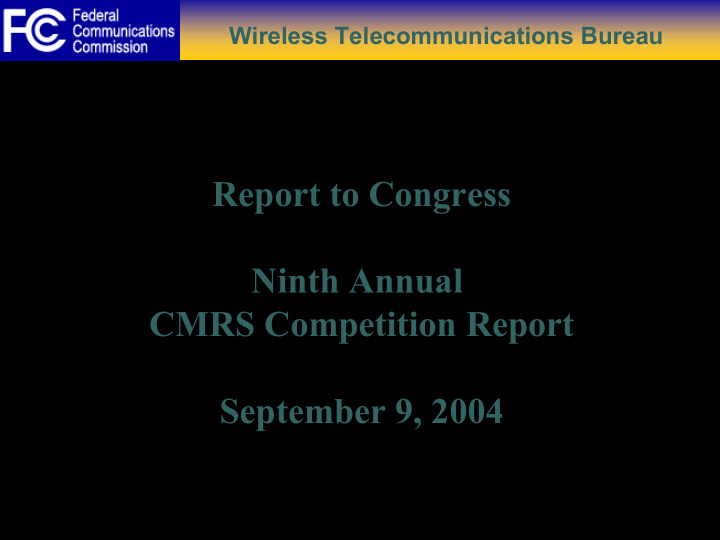



Wireless Telecommunications Bureau Report to Congress Ninth Annual CMRS Competition Report September 9, 2004
Wireless Telecommunications Bureau Growth in the Mobile Telephone Industry (YE2002-YE2003) 161 Million 205,629 Jobs in 146 Billion 507 Average Monthly Subscribers in 2003 2003 Invested as of 2003 MOUs in 2003 UP UP UP UP 7% 15% 19% 13% From From $127 From 427 From Price per 192,410 Billion as MOUs in 142 Million Jobs in of 2003 minute Subscribers 2002 2002 in 2002 Minutes of Subscribers Jobs Capital DOWN Use Investment 13% From $0.11 per minute in 2002 Price per minute Source: Cellular Telecommunications & Internet Association; FCC. 10¢ in 2003
Wireless Telecommunications Bureau Total US Mobile Telephone Wireless Subscribers 175 161 150 142 128 Millions of Subscribers 125 110 100 86 69 75 55 44 50 34 24 25 16 0 1993 1994 1995 1996 1997 1998 1999 2000 2001 2002 2003 Source: Cellular Telecommunications & Internet Association (1992-2000); FCC (2001-2003).
Wireless Telecommunications Bureau Mobile Data Services � 25 percent of all mobile telephone subscribers send text messages � SMS traffic volume rose to more than 2 billion messages per month at the end of 2003, double the June 2002 figure � Some users of text messaging services also use their handsets for leisure/entertainment applications: � Picture messaging – Verizon customers share an average of 7 million pictures per month � Ring tones � Games – 12.2 million Americans downloaded or subscribed to wireless games through their cell phones in 2003 � Simple web browsing Sources: Goldman Sachs (text messaging); CTIA (SMS traffic); Verizon Wireless (picture messaging); Roland Jones, Cell Phone Gaming Gathers Momentum , MSNBC, Aug. 17, 2004 (citing market research firm IDC) (mobile gaming figure).
Wireless Telecommunications Bureau Mobile Telephone Competition 1995 96.8% 100% 93.0% 87.5% 2001 Percent of U.S. Population 2002 80% 75.8% 2003 2004 60% 40% 29.5% 20% 0% 3 or more 4 or more 5 or more 6 or more 7 or more Number of Competitors in a County* *Facilities-based competitors Source: Federal Communications Commission
Wireless Telecommunications Bureau Structure-Conduct-Performance Framework MARKET STRUCTURE � Horizontal concentration � • Number of competitors per market • Market shares Entry conditions � CARRIER CONDUCT MARKET PERFORMANCE � � Pricing and service � Pricing trends � innovations/rivalry Subscriber growth � Investment in network deployment � Usage � & upgrades Service variety & quality � Choice of technological standards � & next-generation migrations paths CONSUMER BEHAVIOR � Access to information � Ability to switch service providers �
Recommend
More recommend